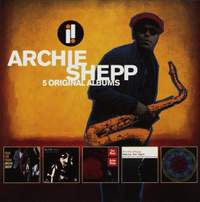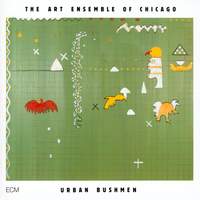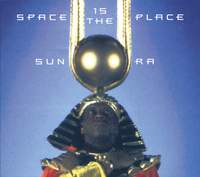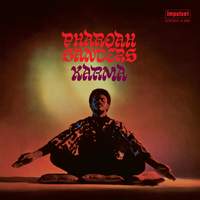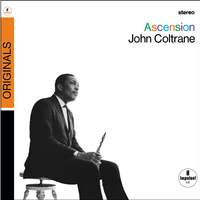Jazz Genre Guides,
Free Jazz
Welcome to the first in a series of listening guides on different genres in jazz, whereby we choose some of the recordings that have had the most impact on us over the years. For this first installment I am looking at free jazz, a genre that continues to fascinate (and frequently confound) me since I was first exposed to it many moons ago.
As a genre, free jazz can be difficult to pin down because in many ways it never really existed as a unified movement or discipline, at least not in the same way that genres like bebop, hard bop, the cool school of the West Coast or swing had, because, by definition, free jazz is an attempt to break away from the very rules and restrictions that defined those other scenes. To put it into the context of the late-fifties, If you were a struggling hard bop player you needed to perform at a very high level in order to have any hope of a lasting career, which meant hours of practice perfecting your licks, learning the charts, all the while hoping to make an impression on the live circuit and ultimately be offered a session for a label like Blue Note. Many players felt their creativity was being stifled by this production-line approach, where virtuosity could often take precedence over inspiration. And if this was limiting enough for the soloists, it was even more frustrating for budding drummers and bassists, who had largely had to put up with being subservient to the soloist throughout jazz’s entire history.
 It was Ornette Coleman and his quartet of young upstarts - Don Cherry, Charlie Haden and Billy Higgins - who first brought free jazz to the public consciousness, both on record and in a historic residency at New York’s Five Spot club in 1959. Coleman also coined the term with his 1960 album Free Jazz. Rather than following pre-written chord changes, Coleman’s music would state a theme (ironically some of the most memorable earworms in all of jazz) only to then throw the rulebook out of the window and let their collective inspiration run riot. This absence of any preconceived arrangements is perhaps the most defining feature in free jazz, leaving the performer at liberty to play what they want in the heat of the moment. The drummer isn't required to keep strict time, the bassist has no chart to work to, and the lack of a harmonic foundation allows the soloists to take shards of melody without fitting into agreed chord sequences, which was underlined by lack of the piano's chordal accompaniment in many of the free jazz lineups.
It was Ornette Coleman and his quartet of young upstarts - Don Cherry, Charlie Haden and Billy Higgins - who first brought free jazz to the public consciousness, both on record and in a historic residency at New York’s Five Spot club in 1959. Coleman also coined the term with his 1960 album Free Jazz. Rather than following pre-written chord changes, Coleman’s music would state a theme (ironically some of the most memorable earworms in all of jazz) only to then throw the rulebook out of the window and let their collective inspiration run riot. This absence of any preconceived arrangements is perhaps the most defining feature in free jazz, leaving the performer at liberty to play what they want in the heat of the moment. The drummer isn't required to keep strict time, the bassist has no chart to work to, and the lack of a harmonic foundation allows the soloists to take shards of melody without fitting into agreed chord sequences, which was underlined by lack of the piano's chordal accompaniment in many of the free jazz lineups.
Almost as soon as free jazz became a 'thing', it fragmented into different sub-genres like ‘Fire Music’, ‘The New Thing’, and ‘Free Improvisation’, all of which are touched upon in my recommendations below. It is important to remember the context of the times that this music was made in, being inextricably linked to the civil rights movement of the time, so it feels appropriate to be writing during the Black Lives Matter protests happening at the moment (albeit from the perspective of a white middle-class jazz writer!). When I first encountered this music I couldn’t believe the honesty, sheer intensity and anger that was being communicated, and led (I hope) to me learning more about Black history, and gaining a deeper understanding of the issues that were, and still are, hampering the progression of humanity. It was in many ways an attempt to reclaim jazz as a Black musical form, which had been progressively commodified and appropriated by white culture (to the extent that Dave Brubeck was the first jazz artist to get a Time Out cover, ahead of Duke Ellington). Ultimately much of the music was so strange and antagonistic that it put off all the most hardened listeners of any colour, and ironically found its most receptive long-term audience in Europe, influencing artists like Peter Brotzmann, Derek Bailey, and Han Bennink who formed the 'free improvisation' scene of the late sixties and beyond.
 I decided to write this subjective guide because, much like the post-war avant-garde in classical music, which was similarly exploding all conventions, for every free jazz album that is a triumph there will be several unfocussed free-for-alls that that fail to land, because it took true vision and courage to make the most of this newfound freedom. Many of the mainstream jazz players took umbrage at the apparent shortage of technical chops at the time, with Miles Davis in particular denouncing artists like Coleman. How ironic then that as the sixties progressed many of these same artists absorbed many of the innovations, so that an album like Bitches Brew would being inconceivable without the contribution of the free jazz fraternity.
I decided to write this subjective guide because, much like the post-war avant-garde in classical music, which was similarly exploding all conventions, for every free jazz album that is a triumph there will be several unfocussed free-for-alls that that fail to land, because it took true vision and courage to make the most of this newfound freedom. Many of the mainstream jazz players took umbrage at the apparent shortage of technical chops at the time, with Miles Davis in particular denouncing artists like Coleman. How ironic then that as the sixties progressed many of these same artists absorbed many of the innovations, so that an album like Bitches Brew would being inconceivable without the contribution of the free jazz fraternity.
In the hands of the supreme practitioners listed below, free jazz offers a unique opportunity to walk the border-zone between chaos and transcendence, and unlimited freedom of expression. Don’t even try playing it as background music, as you’ll only antagonise friends and family. Strap on some cans, open your mind, and you’ll eventually find a portal that takes you into a brave new world.
Let’s start with the obvious first choice, Ornette Coleman’s game-changing Free Jazz - not simply for that title, but because it’s actually tremendous fun to listen to. Featuring Coleman’s core quartet of Don Cherry, Charlie Haden and Billy Higgins, augmented with Freddie Hubbard, Ed Blackwell, master bassist Scott LaFaro and the great Eric Dolphy romping on bass clarinet, this historic session harks back to New Orleans and the earliest concepts of improvisation, whilst staring the future straight in the eye. It’s even got some melody! There’s not a lot to go between the two takes that were taped (the second take was chosen for the original release) but it’s good to have both.
Available Formats: MP3, FLAC
Although i could have just as easily chosen the mid-sixties Blue Note classics Unit Structures or Conquistador!, my favourite Cecil Taylor album is this 1978 session. Bursting with new colours and textures, the inclusion of Raphe Malik’s trumpet and Ramsey Ameen’s violin lends the music quasi Soldier’s Tale-era Stravinskian textures at times. If it sounds chaotic at first, hang in there and let the fuzzy logic come into focus. Unlike some recordings where Taylor doesn’t seem unduly bothered by what his colleagues are playing, this is a true group effort, akin to staring at a lava lamp through a kaleidoscope. It all leads up to the epic thirty-minute 'Holiday En Masque', featuring the still under-appreciated Jimmy Lyons at the top of his game, applying his Charlie Parker-influenced style to some of the most vivid music ever recorded. And of course, there’s Taylor’s torrential piano runs, or ‘eighty-eight tuned drums’ as he famously described his chosen instrument.
Available Formats: CD, MP3, FLAC
Take your pick from any of the five albums on this box, they’re all stone-cold classics. One of the most prominent jazz musicians to actively protest and participate in the civil rights movement, Shepp’s music from the sixties is a scream of righteous anger, voiced in one of the most formidable and recognisable saxophone tones, welding Ben Webster-style swagger to Coltrane’s innovations. My personal favourite, at a pinch, remains Mama Too Tight, but there isn’t a single complacent moment in this entire set.
Available Format: 5 CDs
Hailing from, you guessed it, Chicago, one of the the crucibles of the civil rights movement, the Art Ensemble of Chicago took inspiration from the tribal music of Africa and mixed it with free jazz, rhythm and blues and rock, and blasted it all through their own avant-garde sensibilities to create some of the most evocative improvised music of the second half of the twentieth century. Urban Bushmen benefits from a crystal-clear ECM production, that gives the group’s music a new-found sense of majesty. Joseph Jarman (saxophones), Malachi Favors Maghostus (double bass), Famoudou Don Moye (percussion), Roscoe Mitchell (saxophones), and Lester Bowie (trumpet) were all superb improvisers who had been playing together in various configurations for over twenty years when this was recorded. This is music to get lost in: one minute it can be a percussive tribal gathering with chants, the next a withering parody of military pomposity, and then all-out skronk.
Available Formats: CD, MP3, FLAC
Space is the Place was released on Impulse! in 1972 and has become Sun Ra’s best known album, an excellent place to start exploring his unique musical universe. It features many of the facets that have made his music so enduring through the ages; the hypnotic Afro-futurist themes of ‘Space is the Place’ the Egyptian exotica of ‘Discipline’, space-age free jazz blow-outs of ‘Sea of Sound’, powerful swing band muscle in Images and the humorous Rocket Number Nine which sounds like the theme tune to a Hanna-Barbera cartoon on bad acid. The presence of vocalist June Tyson’s chants helps keep the uninitiated listener on the path through these dense but compelling tone poems.
Available Format: CD
Pharoah Sanders recorded Karma in 1969, two years after the passing of his spiritual leader, John Coltrane, his third recording as a leader. By this point Sanders had harnessed the often terrifying energy of his earliest recordings into an album offering moments of breathtaking beauty, helping to create the spiritual jazz sound that is alive and well today through artists like Kamasi Washington. At over thirty minutes The Creator has a Master Plan forms the bulk of the album, and covers a huge range of emotions and textures, with earlier passages of free blowing resolving into the Edenic closing section, with the short Colours acting as a suitable epilogue.
Available Formats: CD, MP3, FLAC
And finally one of the most daunting recordings ever made, John Coltrane’s Ascension, which with Coleman’s Free Jazz makes a suitable bookend for this guide. In many ways Coltrane had been working towards this historic session all of his life, through his ‘sheets of sound’ approach in the late fifties, then in landmark recordings like 'Chasin’ the Trane' on Live at the Village Vanguard. The gloves were finally off when he assembled Freddie Hubbard, Dewey Johnson, Marion Brown, John Tchicai, Pharoah Sanders, Archie Shepp, McCoy Tyner, Art Davis, Jimmy Garrison and Elvin Jones in the studio on June 28th, 1965 to record this statement. The moons need to be in alignment when I’m in a mental space to cope with this record, as it never lets up, but in the right frame of mind there is nothing else like it.
Available Format: CD




